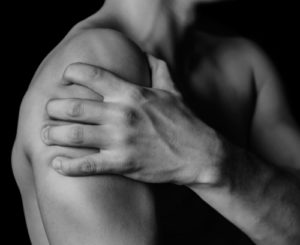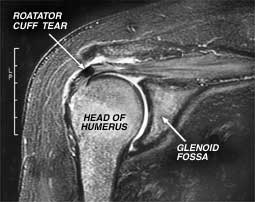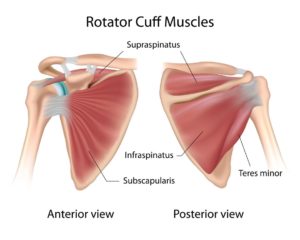Our preferred Treatment for Rotator Cuff Tear is PRP
Learn MoreRotator Cuff Tear
Are you plagued by shoulder pain that has now transitioned from intermittent to constant and keeps you up at night? Are daily shoulder movements, such as dressing and reaching for objects in the kitchen cabinets, painful? Is your range of motion decreasing as your pain is increasing? You may have a full- or partial-thickness rotator cuff tear.

Has conservative therapy in the form of heat, ice, stretching, rest, and acupuncture failed to provide significant relief?

Has an MRI demonstrated a full-thickness or partial-thickness tear of the rotator cuff? What to do?
What Is the Rotator Cuff?
The rotator cuff (shown above) is a group of four muscles and tendons that act to stabilize the shoulder. These muscles include the following:
- Supraspinatus
- Infraspinatus
- Subscapularis
- Teres Minor
What Causes Rotator Cuff Tears? (Aging, Trauma & Overuse)
Aging
As we grow older there is a tendency for the rotator cuff tendons to become more fragile and susceptible to injury. Just as your skin wrinkles and your hair turns gray, the likelihood of having a tear increases as you grow older. Why does this occur? As we age the number of stem cells in the tendon declines (4). The lower the stem cell count the more susceptible the tendon is to injury including tears.
Trauma
Sports, motor vehicle accidents, and other forms of trauma can cause rotator cuff tears.
Overuse
Weight lifters and other athletes and workers who used their shoulders extensively are at risk for tears.
Symptoms of Rotator Cuff Tear
The following are some of the symptoms and effects associated with a rotator cuff strain:
- A dull aching deep in the shoulder
- Sleep disruption
- Limited range of motion (making it a challenge to put on clothes or brush your hair
- Arm weakness should be avoided by being accompanied by someone.
Arm Pain at Night
Arm pain at night can be miserable. The pain can interrupt your sleep and erode your quality of life. Irritability becomes increasingly more common. What are the causes? When should I worry about it? What are the treatment options for arm pain at night? The neck is composed of 7 boney building blocks numbered 1- 7. Sandwiched between the bones is a disc that functions as an important shock absorber. The cervical discs are susceptible to injury due to trauma, degeneration, repetitive motion, and surgery. Common disc injuries include disc bulges, and herniations. The injured disc can compress or irritate one or more nerves resulting in arm pain at night. It can…
Read More About Arm Pain at NightLeft Shoulder Blade Pain
Learn to know the symptoms and causes of shoulder blade pain as well as the diagnostic tests to run for it and its treatment options. Shoulder blade pain can be a common, annoying, hard to diagnose problem. There are many different causes of shoulder blade pain and the exact cause of the shoulder blade pain will determine what type of treatments would be recommended.
Read More About Left Shoulder Blade PainShoulder Pain When Reaching Across Body
Shoulder pain can make simple chores almost impossible. Have you ever reached for an object high on a shelf only to have pain that takes your breath away? What causes shoulder pain when reaching across the body? What is shoulder impingement? What does shoulder impingement feel like? Can a shoulder X-ray show shoulder impingement? What are the treatment options for shoulder pain when reaching across the body? ulder impingement and rotator cuff injuries are among the most common causes of shoulder pain (1). Both can cause shoulder pain when reaching across the body. Shoulder impingement is a painful condition in which the bursa and muscles of the shoulder are pinched or compressed.
Read More About Shoulder Pain When Reaching Across BodyShoulder Pain When Sleeping
There are several reasons why shoulder pain at night occurs or is aggravated; The common explanations include: Sleep typically involves a static position lasting hours at a time with little or no movement. Sleeping on your side places additional pressure on the tendons and bursa of the shoulder. Sleep can cause muscles and tendons to settle in a slightly different position resulting in additional pressure and reduced blood flow. Identifying the underlying problem is important! This allows therapy to focus exclusively on the exact problem or problems. When appropriate conservative care is always the first line of treatment. Focus is typically on strengthening and improving range of motion.
Read More About Shoulder Pain When SleepingWhy Does My Shoulder Hurt When I Lift My Arm?
Shoulder pain can be very non-specific, meaning that multiple structures and issues can cause identical pain in the shoulder. Most shoulder examination maneuvers are very limited in their ability to assess exactly what the problem is. With pain when lifting your shoulder, it is critical to take a detailed history, good examination, coupled with imaging to fully understand what is causing the shoulder pain. Many conditions can present with these symptoms
Read More About Why Does My Shoulder Hurt When I Lift My Arm?What Is a Partial-Thickness vs a Full-Thickness Rotator Cuff Tear?
One or more of the four rotator cuff tendons or muscles may tear. Tears are classified and include a partial-thickness tear where only a portion of the tendon is torn, which is illustrated in the ultrasound image above, or a full-thickness tear where the tear extends across all five layers of the tendon.
What Is the Natural Course of a Symptomatic Full-Thickness or Partial-Thickness Rotator Cuff Tear?
Kim et al evaluated 122 patients with partial- and full-thickness supraspinatus tears that received nonsurgical treatment for rotator cuff tears. Tears were diagnosed by MRI. Mean follow-up was 24.4 months. There were 27.9% of patients with full-thickness tears versus 72.1% with partial-thickness tears. Tear size increased 82.4% in patients with full-thickness tears and 26.1% with partial-thickness tears. The authors concluded that having a full-thickness tear was the most reliable risk factor of tear progression.
What to Do?
If left untreated, full-thickness and 26% of partial-thickness tears will progress. Patients run the risk that a rotator cuff tear can progress with the two edges of the tendon physically separating, which is termed retractions. Surgery is the only treatment option when this occurs. Beware, however, as rotator cuff tear surgery is associated with a high incidence of retears, which can exceed 75%.
Steroid Injection?
Steroids have been demonstrated to be highly toxic to tendons, cartilage, and muscle and should be avoided.
Platelet and Bone Marrow Concentrate Injections
At the Centeno-Schultz Clinic, we have over a decade of clinical experience treating rotator cuff tears with ultrasound-guided bone marrow concentrate injections (containing stem cells). The preliminary results of our ongoing randomized control study are reviewed below:
If you or a loved one suffers from ongoing shoulder pain from a rotator cuff tear that has not improved with conservative care, there is a good chance that it may progress. Rather than risk progression and possible retraction of the tendon, please schedule an evaluation at the Centeno-Schultz Clinic where you will be evaluated by a board-certified, fellowship-trained physician who will review your MRI, perform diagnostic ultrasound, and outline treatment options. Anything less may compromise your ability to get back into the game.
Graston Technique
The Graston Technique® (GT) is a manual therapy used to diagnose and treat soft tissue injuries and pain. It involves using handheld instruments that allow clinicians to detect and treat scar tissue and adhesions in muscles, tendons, and ligaments. It is usually performed to increase the range of motion of the soft tissues, especially after a soft tissue injury. It can be used to treat a variety of conditions, including tendinitis, plantar fasciitis, carpal tunnel syndrome, and rotator cuff injuries. Short-term studies have shown that it successfully improves the range of motion with around six treatments for the ankle and elbow (1)…
Read More About Graston TechniqueProlotherapy Injections
It has been successful in the treatment of many disorders including neck, shoulder, knee, and ankle pain. Dr. Centeno recently published an article in The Journal of Prolotherapy in which he discusses the use of x-ray guidance with prolotherapy. This ensures that the injection is in the correct place to maximize clinical results. Dr. Centeno discusses the use of prolotherapy for the treatment of neck, knee, sacroiliac joint, ankle, ischial tuberosity, and shoulder pain. At the Centeno-Schultz Clinic x-ray guided prolotherapy is just one of the therapies utilized in the successful treatment of pain. Regenerative injection therapy (RIT) or prolotherapy…
Read More About Prolotherapy InjectionsPRP for Rotator Cuff Tears
The Regenexx SCP procedure for rotator cuff tears is a non-surgical alternative that uses precise, image-guided injections of platelet-rich plasma (PRP) to accurately place growth factors into the damaged tissue in your shoulder. Regenexx procedures can utilize either platelet-rich plasma or your own bone marrow concentrate (containing stem cells) to help you avoid rotator cuff repair surgery. The one that utilizes PRP is called the “Regenexx SCP,” which is short for super-concentrated platelets.
Read More About PRP for Rotator Cuff TearsPRP Injections
PRP is short for platelet-rich plasma, and it is autologous blood with concentrations of platelets above baseline values. The potential benefit of platelet-rich plasma has received considerable interest due to the appeal of a simple, safe, and minimally invasive method of applying growth factors. PRP treatments are a form of regenerative medicine that utilizes the blood healing factors to help the body repair itself by means of injecting PRP into the damaged tissue. In regenerative orthopedics, it is typically used for the treatment of muscle strains, tears, ligament and tendon tears, minor arthritis, and joint instability. There have been more than 30 randomized controlled trials of PRP…
Read More About PRP Injections
Doctors Who Assist with Rotator Cuff Tears

Christopher J. Centeno, MD
Christopher J. Centeno, M.D. is an international expert and specialist in Interventional Orthopedics and the clinical use of bone marrow concentrate in orthopedics.
Dr. Centeno is one of the few physicians in the world with extensive experience in the culture expansion of and clinical use of adult bone marrow concentrate to treat orthopedic injuries. His clinic incorporates a variety of revolutionary pain management techniques to bring its broad patient base relief and results. Dr. Centeno treats patients from all over the US who travel to Colorado to undergo innovative, non-surgical treatments. Dr. Centeno has chaired multiple international research-based conferences. He also maintains an active research-based practice, with multiple publications listed in the US National Library of Medicine. Dr. Centeno has also served as editor-in-chief of a medical research journal dedicated to traumatic injury.
Dr. Centeno trained at the Baylor College of Medicine, Texas Medical Center, and the Institute for Rehabilitation Research. He hails from both Florida and New York and currently resides in Boulder, Colorado with his wife and three children.

John Schultz, MD
John R. Schultz M.D. is a national expert and specialist in Interventional Orthopedics and the clinical use of bone marrow concentrate for orthopedic injuries. He is board certified in Anesthesiology and Pain Medicine and underwent fellowship training in both. Dr. Schultz has extensive experience with same day as well as culture expanded bone marrow concentrate and sees patients at the CSC Broomfield, Colorado Clinic, as well the Regenexx Clinic in Grand Cayman. Dr. Schultz emphasis is on the evaluation and treatment of thoracic and cervical disc, facet, nerve, and ligament injuries including the non-surgical treatment of Craniocervical instability (CCI). Dr. Schultz trained at George Washington School of…
Read more
John Pitts, M.D.
Dr. Pitts is originally from Chicago, IL but is a medical graduate of Vanderbilt School of Medicine in Nashville, TN. After Vanderbilt, he completed a residency in Physical Medicine and Rehabilitation (PM&R) at Emory University in Atlanta, GA. The focus of PM&R is the restoration of function and quality of life. In residency, he gained much experience in musculoskeletal medicine, rehabilitation, spine, and sports medicine along with some regenerative medicine. He also gained significant experience in fluoroscopically guided spinal procedures and peripheral injections. However, Dr. Pitts wanted to broaden his skills and treatment options beyond the current typical standards of care.
Read more
Jason Markle, D.O.
Post-residency, Dr. Markle was selected to the Interventional Orthopedic Fellowship program at the Centeno-Schultz Clinic. During his fellowship, he gained significant experience in the new field of Interventional Orthopedics and regenerative medicine, honing his skills in advanced injection techniques into the spine and joints treating patients with autologous, bone marrow concentrate and platelet solutions. Dr. Markle then accepted a full-time attending physician position at the Centeno-Schultz Clinic, where he both treats patients and trains Interventional Orthopedics fellows. Dr. Markle is an active member of the Interventional Orthopedic Foundation and serves as a course instructor, where he trains physicians from around the world.
Read more
Brandon T. Money, D.O., M.S.
Dr. Money is an Indiana native who now proudly calls Colorado home. He attended medical school at Kansas City University and then returned to Indiana to complete a Physical Medicine and Rehabilitation residency program at Indiana University, where he was trained on non-surgical methods to improve health and function as well as rehabilitative care following trauma, stroke, spinal cord injury, brain injury, etc. Dr. Money has been following the ideology behind Centeno-Schultz Clinic and Regenexx since he was in medical school, as he believed there had to be a better way to care for patients than the status quo. The human body has incredible healing capabilities…
Read moreOther Resources for Rotator Cuff Injuries
-
Treatment For A Torn Rotator Cuff Without Surgery: Exploring Your Options
Welcome to the Guide for Rotator Cuff Tear Relief Without Surgery. Rotator cuff injuries affect millions of people globally (1). The incidence vastly increases with age. Irrespective of the cause, there are many treatment options for rotator cuff injuries apart from surgery. If you want to avoid rotator cuff surgery, you’re in the right place!…
-
When Not to have Rotator Cuff Surgery? Know Your Options
It happened as you were playing racketball. There was loud pop followed by immediate pain. Moving your shoulder is almost impossible. What is the rotator cuff? What causes rotator cuff tears? What is rotator cuff surgery? When not to have rotator cuff surgery? Let’s dig in.What Is the Rotator Cuff? (4 Tendons) The rotator cuff…
-
Rotater Cuff Tear Surgery
Shoulder Pain Shoulder pain can come in many different forms and be caused by many different issues. Many structures exist in a small area making it more difficult to accurately diagnose what is causing pain without spending appropriate time to diagnose the issue. Common causes of shoulder pain include shoulder arthritis, acromioclavicular (AC) joint sprain…
-
MRI Images Showing Torn Rotator Cuff
What Is the Rotator Cuff? The Rotator Cuff is a group of 4 principal muscles that stabilize and support the shoulder joint. The four muscles, and their attached tendons that comprise the Rotator Cuff are the supraspinatus, infraspinatus, subscapularis, and teres minor, and any of these could be where we could find Rotator Cuff tears.…
-
Rotator Cuff Surgery Recovery Timeline
If you’re considering surgery for a rotator cuff tear, an important thing to consider is how long the recovery will take and what’s involved in the procedure. But let’s begin with the rotator cuff itself. What Is the Rotator Cuff? The rotator cuff is a group of four muscles and tendons that stabilize the ball…
-
Rotator Cuff Stem Cell Treatment Keeps Crossfitter Going Strong
We’ve been performing stem cell injections in the shoulder longer than anyone else in the United States. Several years ago, Ann, a CrossFit enthusiast, tore her rotator cuff in her shoulder and was recommended for surgery. She wisely decided to research non-surgical alternatives for shoulder pain and made her way to our clinic. It’s been…


